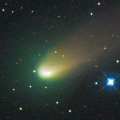
|
Now it is so bright as 9.6 mag (Feb. 20, Juan Jose Gonzalez). It keeps observable bright as 9-10 mag in a good condition for a long time until spring. It keeps observable until autumn when it fades down to 16 mag.
Date(TT) R.A. (2000) Decl. Delta r Elong. m1 Best Time(A, h)
Feb. 27 13 55.59 -6 52.8 0.780 1.599 128 9.5 3:29 ( 0, 48)
Mar. 6 14 3.16 -6 57.6 0.746 1.602 133 9.5 3:09 ( 0, 48)
|
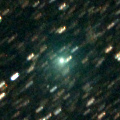
|
Appearing in the morning sky, brighter than expected. Now it is 10.2 mag (Feb. 20, Juan Jose Gonzalez). It will reach up to 8 mag and to be observable in good condition in spring.
Date(TT) R.A. (2000) Decl. Delta r Elong. m1 Best Time(A, h)
Feb. 27 18 52.29 -6 17.1 2.007 1.674 56 10.1 5:08 (301, 28)
Mar. 6 19 1.15 -1 36.0 1.854 1.625 61 9.8 4:59 (300, 33)
|
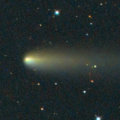
|
It brightened up to 9.5 mag on Jan. 13 (Juan Jose Gonzalez). Now it is still bright as 11.1 mag (Feb. 20, Juan Jose Gonzalez). It keeps as bright as 9-10 mag until spring. It will be observable in good condition for a long time after this in the Northern Hemisphere. It keeps visible visually for one year until autumn.
Date(TT) R.A. (2000) Decl. Delta r Elong. m1 Best Time(A, h)
Feb. 27 15 12.58 49 48.5 2.260 2.765 110 9.8 4:46 (180, 75)
Mar. 6 15 17.90 52 28.2 2.301 2.810 110 10.0 4:24 (180, 73)
|
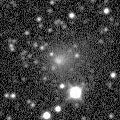
|
Now it is bright as 11.9 mag (Feb. 20, Juan Jose Gonzalez). It will be bright as 9 mag in the northern sky in March and April. In the Southern Hemisphere, it will be observable in the low sky after the perihelion passage only.
Date(TT) R.A. (2000) Decl. Delta r Elong. m1 Best Time(A, h)
Feb. 27 20 45.86 21 53.0 1.312 0.864 41 11.2 5:08 (258, 22)
Mar. 6 21 16.32 28 29.9 1.126 0.790 43 10.5 4:59 (251, 23)
|

|
It reached up to 7.7 mag in last summer (Aug. 13, Chris Wyatt). It is fading now. It has already faded down to 11.0 mag (Feb. 24, A. Novichonok, D. Chestnov). In the Southern Hemisphere, it keeps observable for a long time after this. But in the Northern Hemisphere, it is only observable in the low sky in spring, then it will never be observable again.
Date(TT) R.A. (2000) Decl. Delta r Elong. m1 Best Time(A, h)
Feb. 27 20 11.02 -23 22.8 4.575 3.849 38 11.0 5:08 (301, 2)
Mar. 6 20 13.98 -24 6.5 4.525 3.887 44 11.1 4:59 (304, 5)
|

|
It brightened up to 11.5 mag in January (Jan. 12, Juan Jose Gonzalez). It is still bright as 12.3 mag (Feb. 11, Carlos Labordena). In the Northern Hemisphere, it keeps observable in good condition until spring.
Date(TT) R.A. (2000) Decl. Delta r Elong. m1 Best Time(A, h)
Feb. 27 6 1.78 16 36.1 1.441 2.033 112 13.3 19:34 ( 0, 72)
Mar. 6 6 10.10 17 21.8 1.520 2.045 107 13.6 19:23 ( 6, 72)
|

|
Great outburst up to 11 mag occured on Feb. 2. Now it is still very bright as 10.7 mag (Feb. 21, Marco Goiato).
Date(TT) R.A. (2000) Decl. Delta r Elong. m1 Best Time(A, h)
Feb. 27 9 27.72 12 50.8 5.247 6.196 161 13.5 22:58 ( 0, 68)
Mar. 6 9 24.81 13 0.5 5.289 6.198 154 13.6 22:28 ( 0, 68)
|

|
Appearing in the morining sky. It will brighten up to 12-13 mag in summer. But it locates somewhat low in the Northern Hemisphere.
Date(TT) R.A. (2000) Decl. Delta r Elong. m1 Best Time(A, h)
Feb. 27 18 58.52 -25 8.8 2.871 2.440 54 13.7 5:08 (314, 13)
Mar. 6 19 12.02 -25 10.7 2.800 2.440 58 13.7 4:59 (315, 14)
|
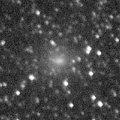
|
It reached up to 8.4 mag in October (Oct. 20, Marco Goiato). Now it is fading. It has already faded down to 12.1 mag (Feb. 11, Carlos Labordena). It will be too low to observe soon.
Date(TT) R.A. (2000) Decl. Delta r Elong. m1 Best Time(A, h)
Feb. 27 0 11.64 -0 59.2 2.825 1.964 24 13.9 19:17 ( 85, 5)
Mar. 6 0 26.66 0 45.2 2.902 2.010 21 14.3 19:23 ( 90, 2)
|
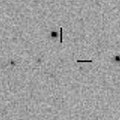
|
Now it is 15.6 mag (Dec. 6, A. Maury, J. B. de Vanssay, F. Mallia, F. Kugel). It will be 14 mag from winter to spring in 2010. But the condition is bad. Now it is not observable. In the Northern Hemisphere, it will appear in the morning sky at 15 mag in late May, then it keeps observable while fading gradually after that.
Date(TT) R.A. (2000) Decl. Delta r Elong. m1 Best Time(A, h)
Feb. 27 23 24.73 -4 12.1 2.670 1.714 12 14.1 19:17 ( 90, -6)
Mar. 6 23 37.74 -0 48.8 2.688 1.718 9 14.2 19:23 ( 95, -9)
|

|
It will approach to the sun down to 0.4 A.U. in July, and it is expected to reach up to 4 mag. It keeps unobservable for a while. It will appear in the morning sky at 12 mag in April. In the Northern Hemisphere, it is observable only until June.
Date(TT) R.A. (2000) Decl. Delta r Elong. m1 Best Time(A, h)
Feb. 27 21 57.66 -13 10.6 3.385 2.421 11 14.5 5:08 (278,-12)
Mar. 6 22 5.75 -11 37.7 3.259 2.320 15 14.2 4:59 (278, -9)
|

|
It brightened up to 15.5 mag in January (Jan. 31, C. Rinner, F. Kugel). It is not observable now. The condition of this apparition is bad. It will reach up to 11-12 mag from spring to autumn in 2010, but it is not observable.
Date(TT) R.A. (2000) Decl. Delta r Elong. m1 Best Time(A, h)
Feb. 27 23 29.77 7 24.2 2.801 1.904 20 14.5 19:17 ( 98, 1)
Mar. 6 23 45.75 8 42.2 2.777 1.857 17 14.3 19:23 (102, -1)
|

|
It brightened up to 11 mag in spring and summer in 2009. Appearing in the morninig sky again. It keeps observable after this until autumn when it becomes fainter than 18 mag while fading gradually. But it locates somewhat low in the Northern Hemisphere.
Date(TT) R.A. (2000) Decl. Delta r Elong. m1 Best Time(A, h)
Feb. 27 18 55.31 -25 37.5 3.076 2.648 55 15.0 5:08 (315, 13)
Mar. 6 19 6.33 -25 28.9 3.022 2.673 60 15.0 4:59 (316, 14)
|
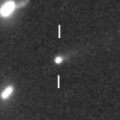
|
Now it is 15.9 mag (Feb. 12, Hidetaka Sato). It was expected to be observable at 15 mag in good condition from winter to spring. But actually, it had been much fainter than expected until January. However, it is brightening very rapidly in February.
Date(TT) R.A. (2000) Decl. Delta r Elong. m1 Best Time(A, h)
Feb. 27 10 21.86 21 50.9 1.277 2.250 166 15.1 23:52 ( 0, 77)
Mar. 6 10 17.10 22 12.5 1.289 2.246 159 15.1 23:20 ( 0, 77)
|

|
Now it is 13.3 mag, already visible visually (Feb. 3, Marco Goiato). It will be observable at 15 mag in good condition in winter and spring.
Date(TT) R.A. (2000) Decl. Delta r Elong. m1 Best Time(A, h)
Feb. 27 5 14.36 21 6.5 1.485 1.938 101 15.1 19:17 ( 28, 75)
Mar. 6 5 24.31 21 53.9 1.540 1.925 96 15.1 19:23 ( 46, 72)
|

|
It was observed as bright as 13.5 mag with a very faint large coma in January (Jan. 16, Michael Jager). However, it did not brighten furthermore after that. Now it is 15.7 mag (Feb. 14, C. Rinner, F. Kugel).
Date(TT) R.A. (2000) Decl. Delta r Elong. m1 Best Time(A, h)
Feb. 27 1 7.69 54 55.9 1.434 1.447 70 15.4 19:17 (136, 40)
Mar. 6 1 18.21 58 0.7 1.439 1.429 69 15.3 19:23 (141, 37)
|

|
Now it is 15.5 mag (Feb. 14, E. Bryssinck, S. Farmer, Jr., P. Camilleri, S. Plaksa). It was observed as 15-16 mag in early 2009. In 2010, it will be observable at 16 mag in good condition from winter to spring.
Date(TT) R.A. (2000) Decl. Delta r Elong. m1 Best Time(A, h)
Feb. 27 14 0.73 -4 43.0 2.937 3.632 128 15.5 3:35 ( 0, 50)
Mar. 6 13 59.72 -4 30.3 2.865 3.637 135 15.5 3:06 ( 0, 50)
|

|
Now it is 18.3 mag (Jan. 26, C. Rinner, F. Kugel). It will be getting brighter rapidly in the morning sky. It keeps observable bright as 9-10 mag for a long time from spring to autumn.
Date(TT) R.A. (2000) Decl. Delta r Elong. m1 Best Time(A, h)
Feb. 27 17 56.32 -13 44.2 2.020 1.911 69 16.0 5:08 (319, 31)
Mar. 6 18 13.45 -13 43.3 1.918 1.869 72 15.5 4:59 (319, 31)
|
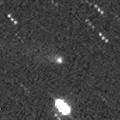
|
Now it is 16.6 mag (Feb. 18, Ken-ichi Kadota), a bit fainter than this ephemeris. It will be observable at 16 mag in good condition until spring.
Date(TT) R.A. (2000) Decl. Delta r Elong. m1 Best Time(A, h)
Feb. 27 15 1.84 26 10.2 2.640 3.194 115 15.7 4:36 ( 0, 81)
Mar. 6 14 48.76 27 9.6 2.581 3.229 122 15.6 3:55 ( 0, 82)
|

|
It brightned up to 10 mag from late 2008 to early 2009. Now it is fading. But it is still bright as 15.8 mag (Feb. 16, Catalina Sky Survey). It keeps observable in good condition at 16 mag for a while.
Date(TT) R.A. (2000) Decl. Delta r Elong. m1 Best Time(A, h)
Feb. 27 9 54.61 3 28.8 4.777 5.749 167 15.7 23:25 ( 0, 58)
Mar. 6 9 50.88 3 35.8 4.855 5.803 161 15.8 22:54 ( 0, 59)
|
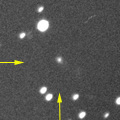
|
Now it is 15.5 mag (Feb. 20, S. Plaksa, E. Bryssinck). It keeps observable at 15 mag for a long time in 2010.
Date(TT) R.A. (2000) Decl. Delta r Elong. m1 Best Time(A, h)
Feb. 27 17 41.85 18 8.8 4.938 4.831 78 15.8 5:08 (293, 57)
Mar. 6 17 46.61 19 34.2 4.842 4.811 82 15.7 4:59 (294, 61)
|

|
Now it is 16.3 mag (Feb. 19, Ken-ichi Kadota). It will be bright as 14-15 mag in spring. It keeps observable for a long time until September when it becomes fainter than 18 mag.
Date(TT) R.A. (2000) Decl. Delta r Elong. m1 Best Time(A, h)
Feb. 27 14 50.61 -25 22.4 1.197 1.797 110 15.9 4:24 ( 0, 30)
Mar. 6 15 3.58 -26 36.3 1.125 1.776 113 15.8 4:10 ( 0, 28)
|
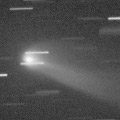
|
It reached up to 8.5 mag on Oct. 15 (Toru Yusa). Now it is fading. It has already faded down to 13.5 mag (Feb. 2, Juan Jose Gonzalez). In the Northern Hemisphere, it keeps observable in good condition for a long time until spring when it becomes fainter than 18 mag.
Date(TT) R.A. (2000) Decl. Delta r Elong. m1 Best Time(A, h)
Feb. 27 5 50.16 19 17.2 1.785 2.312 109 15.8 19:22 ( 0, 74)
Mar. 6 5 57.03 19 59.5 1.923 2.369 104 16.2 19:23 ( 19, 74)
|
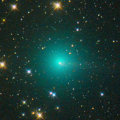
|
It brightened up to 6.7 mag in 2009 June (June 9, Marco Goiato). Now it is 15.3 mag (Feb. 16, Hidetaka Sato). It will be fading after this, and keeps observable until spring when it becomes fainter than 18 mag.
Date(TT) R.A. (2000) Decl. Delta r Elong. m1 Best Time(A, h)
Feb. 27 12 18.64 52 38.8 2.720 3.456 131 15.9 1:54 (180, 73)
Mar. 6 11 57.45 54 43.6 2.799 3.519 130 16.2 1:05 (180, 70)
|
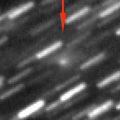
|
It became very bright and observed visually as 9.2 mag (Nov. 18, Juan Jose Gonzalez) and 11.6 mag (Dec. 7, Chris Wyatt) until around the perihelion passage. In January, it approached to the earth down to 0.2 A.U. In the Southern Hemisphere, it is observable in the excellent condition. But it is fading rapidly now. Now it is 15.9 mag (Feb. 19, Yasukazu Ikari). It will be fainter than 18 mag in March.
Date(TT) R.A. (2000) Decl. Delta r Elong. m1 Best Time(A, h)
Feb. 27 8 40.44 4 8.0 0.609 1.549 150 16.1 22:11 ( 0, 59)
Mar. 6 8 41.15 6 49.6 0.718 1.630 144 16.7 21:45 ( 0, 62)
|

|
It brightened up to 13 mag and observed visually from 2007 to 2009. Due to the far distance, it is bright as 14.9 mag still now (Jan. 15, Ken-ichi Kadota). It will be observable in good condition again until spring.
Date(TT) R.A. (2000) Decl. Delta r Elong. m1 Best Time(A, h)
Feb. 27 12 58.90 40 8.2 7.059 7.798 135 16.1 2:33 (180, 85)
Mar. 6 12 52.74 40 50.9 7.070 7.831 137 16.2 2:00 (180, 84)
|

|
Now it is 15.4 mag (Feb. 14, C. Rinner, F. Kugel). It brightened up to 11 mag in outburst in 2003. However, it does not seem to be so bright in this apparition. It seems to be 16 mag at best.
Date(TT) R.A. (2000) Decl. Delta r Elong. m1 Best Time(A, h)
Feb. 27 3 7.35 21 4.4 1.287 1.362 72 16.2 19:17 ( 79, 53)
Mar. 6 3 32.91 21 53.9 1.318 1.369 71 16.3 19:23 ( 81, 52)
|
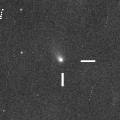
|
It brightened very rapidly, and reached up to 14.8 mag and became visible visually in December (Dec. 4, Juan Jose Gonzalez). But it is fading rapidly now. It has already faded down to 16.5 mag (Feb. 7, L. Buzzi). It will be fainter than 18 mag in late March.
Date(TT) R.A. (2000) Decl. Delta r Elong. m1 Best Time(A, h)
Feb. 27 4 3.26 -5 42.0 1.712 1.828 80 16.5 19:17 ( 35, 43)
Mar. 6 4 18.93 -5 2.6 1.784 1.851 77 16.8 19:23 ( 41, 41)
|

|
It passed near by the earth in late February in 2009, and it reached up to 4.9 mag (Feb. 23, Juan Jose Gonzalez). Now it is 16.8 mag (Jan. 23, Ken-ichi Kadota). It will be low in the evening sky at 17-18 mag in spring.
Date(TT) R.A. (2000) Decl. Delta r Elong. m1 Best Time(A, h)
Feb. 27 4 28.64 20 7.9 5.050 5.154 90 16.8 19:17 ( 54, 68)
Mar. 6 4 27.77 20 8.2 5.242 5.219 83 17.0 19:23 ( 66, 61)
|
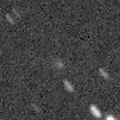
|
Now it is 16.4 mag (Feb. 13, Catalina Sky Survey). It keeps observable at 17 mag in good condition for a while. It will be fainter than 18 mag in June.
Date(TT) R.A. (2000) Decl. Delta r Elong. m1 Best Time(A, h)
Feb. 27 3 1.83 22 12.4 1.704 1.673 71 16.9 19:17 ( 81, 53)
Mar. 6 3 18.48 24 7.7 1.738 1.655 68 16.9 19:23 ( 87, 50)
|
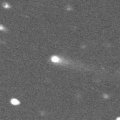
|
Now it is 16.3 mag (Jan. 23, Ken-ichi Kadota). This comet tends to brighten after the perihelion passage. It will be observable at 16 mag in 2010 and 2011. It is brighter than this ephemeris recently.
Date(TT) R.A. (2000) Decl. Delta r Elong. m1 Best Time(A, h)
Feb. 27 4 36.01 23 13.4 2.981 3.184 92 17.1 19:17 ( 56, 71)
Mar. 6 4 41.99 23 18.4 3.079 3.185 86 17.1 19:23 ( 67, 66)
|
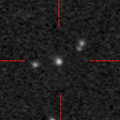
|
Now it is 17.6 mag (Jan. 31, Ken-ichi Kadota). It keeps observable at 17 mag until spring. It will reach up to 14 mag and will be observable in good condition in the next winter.
Date(TT) R.A. (2000) Decl. Delta r Elong. m1 Best Time(A, h)
Feb. 27 6 12.70 66 19.5 4.038 4.431 107 17.3 19:44 (180, 59)
Mar. 6 6 4.42 64 22.2 4.075 4.384 101 17.3 19:23 (177, 61)
|
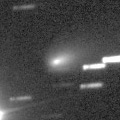
|
It brightened much faster than expected. It became very bright visually at 11.8 mag in December (Dec. 12, Juan Jose Gonzalez). But it is fading rapidly now. It has already faded down to 15.8 mag (Feb. 3, Ken-ichi Kadota). It keeps observable in good condition for a long time. But it will be fainter than 18 mag in late February.
Date(TT) R.A. (2000) Decl. Delta r Elong. m1 Best Time(A, h)
Feb. 27 10 25.35 22 35.1 0.729 1.706 165 17.5 0:00 ( 0, 77)
Mar. 6 10 21.83 23 37.5 0.787 1.751 159 18.0 23:25 ( 0, 79)
|

|
Now it is 17.1 mag (Jan. 27, Hidetaka Sato). It will be fainter than 18 mag in April.
Date(TT) R.A. (2000) Decl. Delta r Elong. m1 Best Time(A, h)
Feb. 27 18 43.94 31 14.9 6.541 6.252 68 17.7 5:08 (262, 51)
Mar. 6 18 47.93 32 7.4 6.540 6.303 71 17.8 4:59 (262, 54)
|
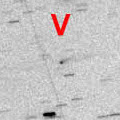
|
Now it is 17.9 mag (Jan. 19, W. Hasubick). It will be fainter than 18 mag in March.
Date(TT) R.A. (2000) Decl. Delta r Elong. m1 Best Time(A, h)
Feb. 27 10 44.45 26 2.0 1.469 2.431 162 17.9 0:19 ( 0, 81)
Mar. 6 10 37.90 26 50.7 1.528 2.476 158 18.1 23:41 ( 0, 82)
|

|
New periodic comet which brightened up to 14 mag in 2004 and 2005. It should be observable at 18 mag also around the aphelion. However, no observations have been reported since 2008 January. It seems to have faded out rapidly. Now it is fainter than 20.4 mag actually (Sept. 16, Leonid Elenin).
Date(TT) R.A. (2000) Decl. Delta r Elong. m1 Best Time(A, h)
Feb. 27 6 16.56 31 10.5 4.408 4.912 115 20.1 19:48 ( 0, 86)
Mar. 6 6 16.32 31 8.9 4.502 4.903 108 20.2 19:23 ( 8, 86)
|
|
![]()
 43P/Wolf-Harrington
43P/Wolf-Harrington 116P/Wild 4
116P/Wild 4 94P/Russell 4
94P/Russell 4 30P/Reinmuth 1
30P/Reinmuth 1 C/2009 U3 ( Hill )
C/2009 U3 ( Hill ) 74P/Smirnova-Chernykh
74P/Smirnova-Chernykh 10P/Tempel 2
10P/Tempel 2 C/2008 N1 ( Holmes )
C/2008 N1 ( Holmes ) C/2006 OF2 ( Broughton )
C/2006 OF2 ( Broughton ) C/2008 FK75 ( Lemmon-Siding Spring )
C/2008 FK75 ( Lemmon-Siding Spring ) P/2010 A5 ( LINEAR )
P/2010 A5 ( LINEAR ) 217P/2009 F3 ( LINEAR )
217P/2009 F3 ( LINEAR ) C/2008 Q3 ( Garradd )
C/2008 Q3 ( Garradd ) 169P/NEAT
169P/NEAT C/2005 L3 ( McNaught )
C/2005 L3 ( McNaught ) 157P/Tritton
157P/Tritton P/2009 T2 ( La Sagra )
P/2009 T2 ( La Sagra ) C/2007 N3 ( Lulin )
C/2007 N3 ( Lulin ) P/2010 A3 ( Hill )
P/2010 A3 ( Hill ) 203P/2008 R4 ( Korlevic )
203P/2008 R4 ( Korlevic ) C/2010 B1 ( Cardinal )
C/2010 B1 ( Cardinal ) P/2009 Q4 ( Boattini )
P/2009 Q4 ( Boattini ) C/2006 Q1 ( McNaught )
C/2006 Q1 ( McNaught ) 230P/2009 U6 ( LINEAR )
230P/2009 U6 ( LINEAR ) P/2004 F3 ( NEAT )
P/2004 F3 ( NEAT )![]()
































